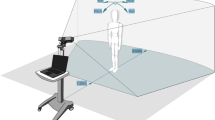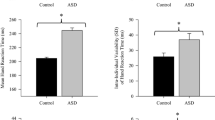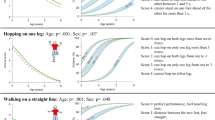Abstract
Background:
Motor impairment in children with Asperger Syndrome (AS) or High functioning autism (HFA) has been reported previously. This study presents results of a quantitative assessment of neuromotor skills in 14–22 year old HFA/AS.
Methods:
16 HFA/AS and 16 IQ-matched controls were assessed by the Zurich Neuromotor Assessment (ZNA).
Results:
The HFA/AS group showed strongest impairments of dynamic balance skills and diadochokinesis. Motor abilities were associated with degree of social withdrawal in the full sample and severity of current autistic symptoms in the HFA/AS group.
Conclusion:
Similar motor patterns as in younger children were found in the older adolescents. The association of autistic symptoms with motor performance points towards an essential role of motor impairment in autism spectrum disorders.
Similar content being viewed by others
References
Abell, F., Krams, M., Ashburner, J., Passingham, R., Friston, K., Frackowiak, R., Happé, F., Frith, C., & Frith, U. (1999). The neuroanatomy of autism: a voxel-based whole brain analysis of structural scans. NeuroReport, 10, 1647–1651.
Achenbach, T. M. (1991). Manual for the youth self-report and 1991 profile. Burlington, VT: University of Vermont Department of Psychiatry.
Achenbach, T. M. (1997). Manual for the young adult self-report and young adult behaviour checklist. Burlington, VT: University of Vermont Department of Psychiatry.
Allen, G., Muller, R. A., & Courchesne, E. (2004). Cerebellar function in autism: functional magnetic resonance image activation during a simple motor task. Biological Psychiatry, 56, 269–278.
American Psychiatric Association (1994). Diagnostic and statistical manual of mental disorders (DSM-IV) (4th ed.). Washington, DC: American Psychiatric Association.
Arbeitsgruppe Deutsche Child Behavior Checklist (1999). Deutsche Bearbeitung der Child Behavior Checklist (CBCL/4–18)––Einführung und Anleitung zur Handauswertung, 2. Auflage mit deutschen Normen. Koeln: Arbeitsgruppe Kinder-, Jugend- und Familiendiagnostik .
Bauman, M. L., & Kemper, T. L. (2005). Neuroanatomic observations of the brains in autism: a review and future directions. International Journal of Developmental Neuroscience, 23, 183–187.
Bölte, S., & Poustka, F. (2004). The German form of the Autism Diagnostic Observation Schedule (ADOS): first results on reliability and validity. Zeitschrift fur Kinder-und Jugendpsychiatrie und Psychotherapie, 32, 45–50.
Bruininks R. (1978). Bruininks oseretsky test of motor proficiency. Circle Pines MN: American Guidance Service.
Cody, H., Pelphrey, K., & Piven, J. (2002). Structural and functional magnetic resonance imaging of autism. International Journal of Developmental Neurosciences, 20, 412–438.
Gepner, B., Mestre, D., Masson, G., & de Schonen, S. (1995). Postural effects of motion vision in young autistic children. Neuroreport, 30, 1211–1214.
Ghaziuddin, M., Butler, E., Tsai, L., & Ghaziuddin, N. (1994). Is clumsiness a marker for Asperger syndrome? Journal of Intellectual Disabilities Research, 38, 519–527.
Ghaziuddin, M., & Butler, E. (1998). Clumsiness in autism and Asperger syndrome: A further report. Journal of Intellectual Disabilities Research, 42, 43–48.
Gillberg, C. (1989). Asperger’s syndrome in 23 Swedish children. Developmental Medicine and Child Neurology, 31, 520–531.
Green, D., Baird, G., Barnett, A. L., Henderson, K., Huber, J., & Henderson, S. E. (2002). The severity and nature of motor impairment in Asperger’s syndrome: A comparison with Specific Developmental Disorder of Motor Function. Journal of Child Psychology and Psychiatry, 43, 655–668.
Hallett, M., Lebiedowska, M. K., Thomas, S. L., Stanhope, S. J., Denckla, M. B., & Rumsey, J. (1993). Locomotion of autistic adults. Archives of Neurology, 50, 1304–1308.
Hardan, A. Y., Kilpatrick, M., Keshavan, M. S., & Minshew, N. J. (2003). Motor performance and anatomic magnetic resonance imaging (MRI) of the basal ganglia in autism. Journal of Child Neurology, 18, 317–324.
Henderson, S. E., & Sugden, D. (1992). The movement assessment battery for children. London: The Psychological Corporation.
Hill, E. L., & Frith, U. (2003). Understanding of autism: insights from mind and brain. Philosophical Transactions of the Royal Society London B, 358, 281–289.
Hughes, C. (1996). Brief report: Planning problems in autism at the level of motor control. Journal of Autism and Developmental Disorders, 26, 99–107.
Jones, V., & Prior, P. (1985). Motor imitation abilities and neurological signs in autistic children. Journal of Autism and Developmental Disorders, 15, 31–45.
Kohen-Raz, R., Volkmar, F. R., & Cohen, D.J. (1992). Postural control in children with autism. Journal of Autism and Developmental Disorders, 22, 419–432.
Largo, R. H., Fischer, J., & Caflish, J. (2002). Zürcher neuromotorik. Zürich: AWE-Verlag.
Largo, R. H., Caflisch, J. A., Hug, F., Muggli, K., Molnar, K., Molinari, L., Sheehy, A., & Gasser, T. (2001a). Neuromotor development from 5 to 18 years. Part 1: Timed performance. Developmental Medicine and Child Neurology, 42, 436–443.
Largo, R. H., Caflisch, J. A., Hug, F., Muggli, K., Molnar, K., & Molinari, L. (2001b). Neuromotor development from 5 to 18 years. Part 2: Associated movements. Developmental Medicine and Child Neurology, 42, 444–453.
Leary, M. R., & Hill, D. A. (1996). Moving on: autism and movement disturbance. Mental Retardation, 34, 39–53.
Lord, C., Risi, S., Lambrecht, L., Cook, E. H., Leventhal, B. L., DiLavore, P. C., Pickles, A., & Rutter, M. (2000). The Autism Diagnostic Observation Schedule—Generic: A standard measure of social and communication deficits associated with the spectrum of autism. Journal of Autism and Developmental Disorders, 30, 205–223.
Lord, C., Rutter, M., & LeCouteur, A. (1994). Autism Diagnostic Interview—Revised : A revised version of a diagnostic interview for caregivers of individuals with possible pervasive developmental disorders. Journal of Autism and Developmental Disorders, 24, 659–685.
McAlonan, G., Cheung, V., Cheung, C., Suckling, J., Lam, G. Y., Tai, K. S., Yip, L., Murphy, D. C. M., & Chua, S. E. (2005). Mapping the brain in autism. A voxel-based MRI study of volumetric differences and intercorrelations in autism. Brain, 128, 268–276.
Manjiviona, J., & Prior, M. (1995). Comparison of Asperger Syndrome and high functioning autistic children on a test of motor impairment. Journal of Autism and Developmental Disorders, 25, 23–39.
Mari, M., Castello, U., Marks, D., Marraffa, C., & Prior, M. (2003). The reach-to-grasp movement in children with autism spectrum disorder. Philosophical Transactions of the Royal Society of London. Series B, Biological Sciences, 358, 393–403.
Minshew, N. J., Goldstein, G., & Siegel, D. (1997). Neuropsychologic functioning in autism: Profile of a complex information processing disorder. Journal of the International Neuropsychological Society, 3, 303–316.
Minshew, N. J., Sung, K., Jones, B. L., & Furman, J. M. (2004). Underdevelopment of the postural control system in autism. Neurology, 63, 2056–2061.
Miyahara, M., Tsujji, M., Hori, M., Nakanishi, K., Kageyama, H., & Sugiyama T. (1997). Brief report: Motor incoordination in children with Asperger’s syndrome and learning disabilities. Journal of Autism and Developmental Disorders, 27, 597–604.
Molloy, C. A., Dietrich, K. N., & Bhattacharya, A. (2003). Postural stability in children with autism spectrum disorder. Journal of Autism and Developmental Disorders, 33, 643–652.
Nayate, A., Bradshaw, J. L., & Rinehart, N. J. (2005). Autism and Asperger’s disorder: Are they movement disorders involving the cerebellum and/or basal ganglia? Brain Research Bulletin, 67, 327–334.
Noterdaeme, M., Mildenberger, K., Minow, F., & Amorosa, H. (2002). Evaluation of neuromotor deficits in children with autism and children with a specific speech and language disorder. European Child and Adolescent Psychiatry, 11, 219–225.
Oldfield, R. C. (1971). The assessment and analysis of handedness: The Edinburgh inventory. Neuropsychologia, 9, 97–113.
Ozonoff, S., Cook, I., Coon, H., Dawson, G., Joseph, R. M., Klin, A., McMahon, W. M., Minshew, N., Munson, J. A., Pennington, B. F., Rogers, S. J., Spence, M. A., Tager-Flusberg, H., Volkmar, F. R., & Wrathall, D. (2004). Performance on the Cambridge Neuropsychological Test Automated Battery subtests sensitive to frontal lobe function in people with autistic disorder: Evidence from the Collaborative Programs of Excellence in Autism network. Journal of Autism and Developmental Disorders, 34, 139–150.
Poustka, F., Lisch, S., Ruhl, D., Sacher, A., Schmotzer, G., & Werner, K. (1996). The standardized diagnosis of autism, Autism Diagnostic Interview-Revised: interrater reliability of the German form of the interview. Psychopathology, 29, 145–153.
Rinehart, N. J., Bradshaw, J. L., Brereton, A. V., & Tonge, B. J. (2001). Movement preparation in High-Functioning Autism and Asperger Disorder: A serial choice reaction time task involving motor reprogramming. Journal of Autism and Developmental Disorders, 31, 79–88.
Szatmari, P., Tuff, L., Finlayson, M. A., & Bartolucci, G. (1990). Asperger’s syndrome and autism: neurocognitive aspects. Journal of the American Academy of Child and Adolescent Psychiatry, 29, 130–136.
Teitelbaum, O., Benton, T., Shah, P. K., Prince, A., Kelly, J. L., Teitelbaum, P. (2004). Eshkol-Wachman movement notation in diagnosis: the early detection of Asperger’s syndrome. Proceedings of the National Academy of Sciences of the United States of America, 101, 11909–11914.
Touwen, B. (1982). Die Untersuchung von Kindern mit geringen neurologischen Funktionsstörungen. Stuttgart: Thieme.
Tsatsanis, K. D., Rourke, B. P., Klin, A., Volkmar, F. R., Cicchetti, D., & Schultz, R. T. (2003). Reduced thalamic volume in high-functioning individuals with autism. Biological Psychiatry, 53, 121–129.
Vernazza-Martin, S., Martin, N., Vernazza, A., Lepellec-Muller, A., Rufo, M., Massion, J., & Assaiante, C. (2005). Goal directed locomotion and balance control in autistic children. Journal of Autism and Developmental Disorders, 35, 91–102.
Vilensky, J. A., Damasio, A. R., & Maurer, R. G. (1981). Gait disturbances in patients with autistic behavior. Archives of Neurology, 38, 646–649.
World Health Organization (1992). The ICD-10 classification of mental and behavioural disorders. Clinical description and diagnostic guidelines. Geneva: WHO.
Young, R. L., Brewer, N., & Pattison, C. (2004). Parental identification of early behavioural abnormalities in children with autistic disorder. Autism, 7, 125–143.
Acknowledgments
We thank the adolescents and the parents who took part in the study. This research was supported by the Saarland University, Germany.
Author information
Authors and Affiliations
Corresponding author
Rights and permissions
About this article
Cite this article
Freitag, C.M., Kleser, C., Schneider, M. et al. Quantitative Assessment of Neuromotor Function in Adolescents with High Functioning Autism and Asperger Syndrome. J Autism Dev Disord 37, 948–959 (2007). https://doi.org/10.1007/s10803-006-0235-6
Published:
Issue Date:
DOI: https://doi.org/10.1007/s10803-006-0235-6




